
A sepal is a part of the flower of angiosperms. Usually green, sepals typically function as protection for the flower in bud, and often as support for the petals when in bloom.

The Aristolochiaceae are a family, the birthwort family, of flowering plants with seven genera and about 400 known species belonging to the order Piperales. The type genus is Aristolochia L.
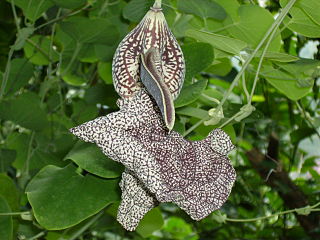
Aristolochia is a large plant genus with over 500 species that is the type genus of the family Aristolochiaceae. Its members are commonly known as birthwort, pipevine or Dutchman's pipe and are widespread and occur in the most diverse climates. Some species, like A. utriformis and A. westlandii, are threatened with extinction.

Battus philenor, the pipevine swallowtail or blue swallowtail, is a swallowtail butterfly found in North America and Central America. This butterfly is black with iridescent-blue hindwings. They are found in many different habitats, but are most commonly found in forests. Caterpillars are often black or red, and feed on compatible plants of the genus Aristolochia. They are known for sequestering acids from the plants they feed on in order to defend themselves from predators by being poisonous when consumed. The adults feed on the nectar of a variety of flowers. Some species of Aristolochia are toxic to the larvae, typically tropical varieties. While enthusiasts have led citizen efforts to conserve pipevine swallowtails in their neighborhoods on the West coast, the butterfly has not been the subject of a formal program in conservation or protected in legislation. The butterfly is however of "Special Concern" in Michigan, which is on the Northern limit of its range.
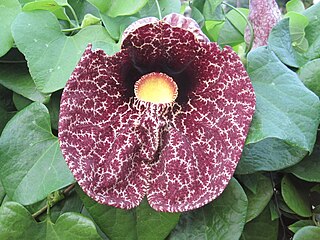
Aristolochia littoralis, the calico flower or مورپنکھ بیل or elegant Dutchman's pipe, is a species of evergreen vine belonging to the family Aristolochiaceae.

Aristolochia rotunda, commonly known as smearwort or round-leaved birthwort, is a herbaceous perennial plant native to Southern Europe.

Stephania is a genus of flowering plants in the family Menispermaceae, native to eastern and southern Asia and Australia. They are herbaceous perennial vines, growing to around four metres tall, with a large tuber. The leaves are arranged spirally on the stem and are peltate, with the leaf petiole attached near the centre of the leaf. The name Stephania comes from the Greek, "a crown". This refers to the anthers being arranged in a crown-like manner.

Aristolochia gigantea, the Brazilian Dutchman's pipe or giant pelican flower, is an ornamental plant native to Brazil. Typical of subtropical Bahia and Minas Gerais vegetation, it is a vigorous evergreen climber (vine) with heart-shaped leaves and spectacular fragrant flowers. This plant is cited in Flora Brasiliensis by Carl Friedrich Philipp von Martius. A. gigantea and other tropical Dutchman's pipe varieties pose a threat to the pipevine swallowtail butterfly. The butterfly confuses A. gigantea with its native host plant and will lay eggs on it although pipevine swallowtail caterpillars cannot survive on the foliage.

Aristolochia labiata, the mottled Dutchman's pipe or rooster flower, is an ornamental plant which is native to Brazil.
Pararistolochia is a formerly accepted genus in the plant family Aristolochiaceae. As of March 2023, it is considered a synonym of the genus Aristolochia.

Aristolochia grandiflora, the pelican flower, is a deciduous vine with one of the world's largest flowers that emits an odor that smells like rotting meat, attracting flies.

Aristolochia indica is a creeper plant found in Southern India and also Sri Lanka. It Is known as 'sapsada' in Sri Lanka and is critical to the survival of the southern birdwing and common birdwing, as well as crimson and common rose butterflies. It reaches a height of several metres on trees and cover the branches with thick foliage. It is commonly found in forest floor, rocky hillslopes. It flowers once a year to produce seeds. It can also be propagated by roots. The plant has a number of historical medicinal uses.
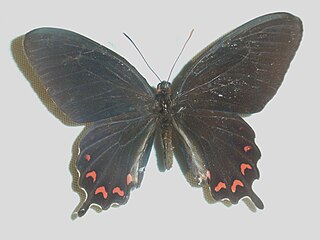
Parides montezuma, the Montezuma's cattleheart, is a butterfly in the family Papilionidae. It is native to the Americas.

Passiflora gibertii is a fast-growing ornamental vine with edible fruits. The flowers are also ornamental. The fast-growing vine can grow up to 8.2 m (27 ft) long. It has three-lobed leaves which can grow to a few inches long. Vines may trail across arbors or climb trees or fences. The plant is easily container-grown and will flower readily. Flowering generally occurs in warm months. Some fruits may follow, and the ripe fruits which are yellow to orange in color are edible, though some reports claim the unripe fruits are poisonous. Its hardiness is to about 0 °C (32 °F). It grows in full sun or in part shade. The vines need regular water, especially during the growing season. Vines can be pruned if needed, as secondary shoots readily sprout. Seeds benefit from presoaking and require warm temperatures of 24–29 °C (75–85 °F) for germination. Germination time is erratic and often takes several weeks to a few months. P. gibertii is not as commonly planted as some of the other Passifloras. It is native to South America, from Argentina through Paraguay and Brazil.
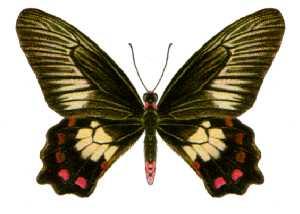
Pachliopta polydorus, the red-bodied swallowtail, is a butterfly from the family Papilionidae found in north-eastern Queensland, Australia and Papua New Guinea.

Aristolochia acuminata, the native Dutchman's pipe or Indian birthwort is a poisonous perennial vine that is endemic to Asia and Malesia, New Guinea and the Solomon Islands and northern Australia.
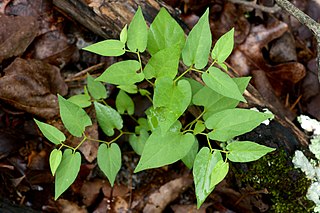
Aristolochia serpentaria is a species of perennial flowering plant in the Aristolochiaceae (birthwort) family. The species is commonly known as Virginia snakeroot and is native to eastern North America, from Connecticut to southern Michigan and south to Texas and Florida.

Aristolochia arborea is a species of perennial plant in the family Aristolochiaceae. It is found from Mexico through Guatemala and El Salvador.
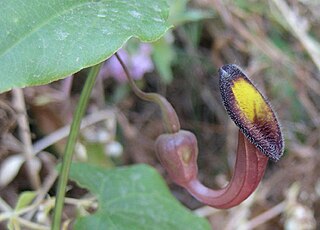
Aristolochia sempervirens is a species of perennial plant in the family Aristolochiaceae. It is found in the Eastern and Southern Mediterranean Basin, notably in Crete.

















